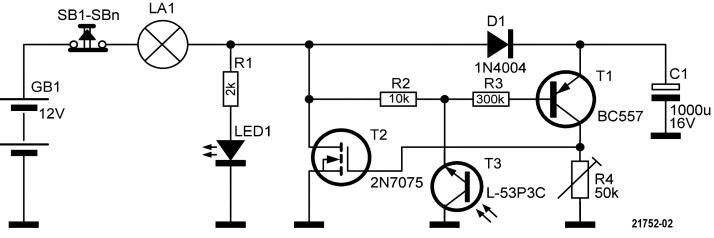Small Circuits Revival (16): Light-sensitive Energy-efficient Relay
on
Light-sensitive Energy-efficient Relay
idea: Michael A. Shustov (Russia), Andrey M. Shustov (Germany)
In e-zine issue 356 from Friday 8 November 2019 we described an ‘all-transistor’ energy-efficient relay for use as a 'stairwell switching circuit. To refresh your mind, we show the schematic for this circuit again (Figure 1).

In the quiescent state, the series-connected, normally-closed pushbuttons SB1 through SBn are closed. LED1 is lit and transistors T1 and T2 are off. Once one of the pushbuttons is depressed, T1 starts to conduct for a period set by the value of capacitor C1 and the wiper position of potentiometer R3 (about 0 to 50 seconds with the values indicated). T2 will then also conduct and a current flows which is large enough to turn on the (incandescent) lamp La1.
The description so far covers the existing circuit. In the new version (Figure 2), two additional components are introduced: resistor R2 with a value of 10 kΩ and photo transistor T3 (an L-53P3C). This now creates a few new interesting possibilities.

The difference with the previous version is that the circuit is not only triggered by pushing one of the buttons, but also when light strikes photo transistor T3 for a short time. Here you could consider using a laser pointer or torch, or, for example, the headlights from your car when you drive into your garage in the dark.
when using an appropriately sized heatsink, transistor T2 is capable of handling reasonably sizeable currents. The circuit is also suitable for other power supply voltages after changing the values of some components.
Note: this circuit is not (repeat: not) suitable for switching incandescent lamps that are connected to the mains!


Discussion (2 comments)